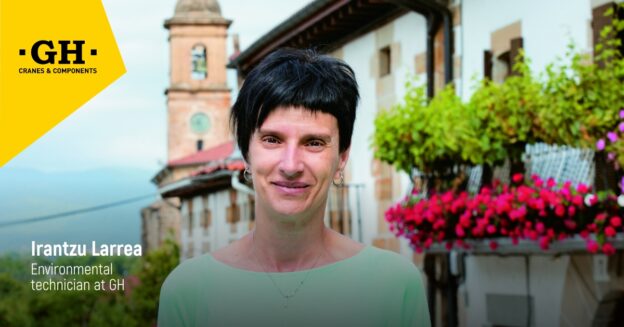A Technical Engineer in the Forestry and Paper Industry with a master’s degree in Environmental Management, throughout her outstanding professional career Irantzu Larrea has held key roles in prevention, the environment and quality. In 2020 she joined GH with the clear objective of achieving ISO 14001, an international standard that establishes the requirements for an effective environmental management system. “More than a point of arrival, this certification is a starting point for environmental sustainability,” she explains.
What is your role at GH? What functions do you perform?
In 2020, GH set itself the goal of becoming ISO 14001 certified and I was entrusted with its implementation. With my experience in environmental matters, I felt that I could achieve the objectives set by the company and obtain certification in a year, but it was particularly hard because it was a year marked by the pandemic. We achieved it in March 2021.
What motivated GH to achieve ISO 14001 in such a short time?
The company had to start becoming more sustainable both internally and externally. First, it had been identified that GH had to comply with the legal environmental requirements defined to meet customer demands. And second, this certification would allow us to be more competitive in tenders, as well as to win new customers and consolidate our presence with existing customers. The implementation and certification of the different standards helps the company to carry out different functions with a defined system.
When you say that GH had to be more sustainable externally and internally, what do you mean?
In discussions in companies, sustainability has always been associated with environmental issues, but the reality is that environmental sustainability implies a balance between economic and social development and the care and protection of nature. In other words, organisations must protect the environment and respond to changing environmental conditions, in balance with socio-economic needs. To do this, they must contribute to sustainable development through different options with a life-cycle perspective.
What does this perspective consist of?
The life cycle is understood as the consecutive and interrelated stages of a product system, from the acquisition of raw materials to final disposal. This concept is also understood as “from the cradle to the grave”.
Could you give us an example of a sustainability initiative that you have recently implemented in the company?
At MECALSA, photovoltaic installations have been carried out and air conditioning equipment has been replaced. In another workshop at GUEMA, conventional lighting has been replaced with LED lights. All of these initiatives aim to reduce purchased energy and CO 2, as well as the use of clean energy.
“Environmental sustainability implies a balance between economic and social Development and the care and protection of nature”
How does the company measure the impact of this type of sustainability initiative?
The impact of environmental initiatives is measured through annually defined indicators derived from the company’s objectives. GH is also in the process of preparing a sustainability report in which different indicators will be established based on social, economic and environmental aspects that will measure the sustainability impact. In addition, the annual calculation of the carbon footprint measures the impact of the organisation’s greenhouse gas emissions.
Can you tell us about any future projects you have in mind to improve sustainability in the company?
With the help of the R&D&I Management Unit, an idea is being promoted to define an Action Plan for reducing the Carbon Footprint, in order to establish a roadmap defining the actions to be carried out in the coming years to reduce CO2 emissions. The intention is to form a work team in which different management and business units intervene.
How does GH involve its employees in sustainability initiatives?
There are different channels. One is through the Innova portal, a platform where any employee can propose an idea related to sustainability, R&D&I or prevention. Another is through committees, and communication regarding sustainability can also take place using the Izaro employee portal.
How do you see the future of sustainability in the crane manufacturing industry? Customers, governments and society as a whole are increasingly putting pressure on companies to place sustainability at the centre of their strategy and business models. For this reason, crane manufacturing companies must also integrate sustainability into their models and establish the measures they can take to adopt a more sustainable business approach.
What motivates you personally to continue working on sustainability and what do you hope to achieve in the future?
Sustainability as a strategy in companies is now a fact and is becoming ncreasingly important. GH has a wide range of motivating opportunities in its business model to become more sustainable, that is, to achieve the best possible balance between the environment, society and the economy, and to align itself with the 2030 agenda.
